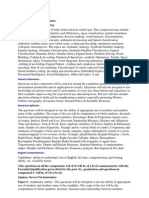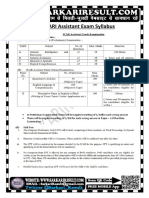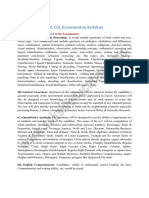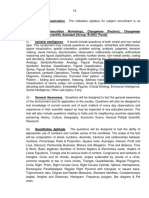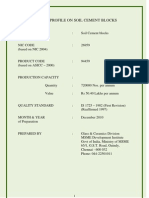Tier
Tier
Uploaded by
William RobersonCopyright:
Available Formats
Tier
Tier
Uploaded by
William RobersonCopyright
Available Formats
Share this document
Did you find this document useful?
Is this content inappropriate?
Copyright:
Available Formats
Tier
Tier
Uploaded by
William RobersonCopyright:
Available Formats
TIER-I OF THE EXAMINATION:
Date of Exam
Part
Subject
Max. Marks/Questions
Total Duration/ Timing for General candidates
Exam Total Duration/Timing for visually Handicapped candidates
19.06.2011 &26.06.2011
A.
General Intelligence & Reasoning
50
B.
General Awareness
50
2 Hours 10.00 A.M. to 12.00 Noon OR
2 Hours 40 Minutes 10.00 A.M. to 12.40 PM OR 2.00 P.M. to 4.40 P.M.
C.
Numerical Aptitude
50
2.00 P.M. to 4.00 P.M.
D.
English Comprehension
50
A. General Intelligence & Reasoning: It would include questions of both verbal and non-verbal type. This component may include questions on analogies, similarities and differences, space visualization, spatial orientation, problem solving, analysis, judgement, decision making, visual memory, discrimination, observation, relationship concepts, arithmetical reasoning and figural classification, arithmetic number series, non-verbal series, coding and decoding, statement conclusion, syllogistic reasoning etc. The topics are, Semantic Analogy, Symbolic/Number Analogy, Figural Analogy, Semantic Classification, Symbolic/Number Classification, Figural Classification, Semantic Series, Number Series, Figural Series, Problem Solving, Word Building, Coding & de-coding, Numerical Operations, symbolic Operations, Trends, Space Orientation, Space Visualization, Venn Diagrams, Drawing inferences, Punched hole/ pattern folding & un-folding, Figural Pattern folding and completion, Indexing, Address matching, Date & city matching, Classification of centre codes/roll numbers, Small & Capital letters/numbers coding, decoding and classification, Embedded Figures, Critical thinking, Emotional Intelligence, Social Intelligence, Other sub-topics, if any. B. General Awareness: Questions in this component will be aimed at testing the candidates general awareness of the environment around him and its application to society. Questions will also be designed to test knowledge of current events and of such matters of every day observations and experience in their scientific aspect as may be expected of any educated person. The test will also include questions relating to India and its neighbouring countries especially pertaining History, Culture, Geography, Economic Scene, General Policy & Scientific Research. C. Numerical Aptitude: The questions will be designed to test the ability of appropriate use of numbers and
number sense of the candidate. The scope of the test will be computation of whole numbers, decimals, fractions, and relationships between numbers, Percentage. Ratio & Proportion, Square roots, Averages, Interest, Profit and Loss, Discount, Partnership Business, Mixture and Allegation, Time and distance, Time & Work, Basic algebraic identities of School Algebra & Elementary surds, Graphs of Linear Equations, Triangle and its various kinds of centres, Congruence and similarity of triangles, Circle and its chords, tangents, angles subtended by chords of a circle, common tangents to two or more circles, Triangle, Quadrilaterals, Regular Polygons , Circle, Right Prism, Right Circular Cone, Right Circular Cylinder, Sphere, Hemispheres, Rectangular Parallelepiped, Regular Right Pyramid with triangular or square base, Trigonometric ratio, Degree and Radian Measures, Standard Identities, Complementary angles, Heights and Distances, Histogram, Frequency polygon, Bar diagram & Pie chart. D. English Comprehension: Candidatesability to understand correct English, his basic comprehension, and writing ability, etc. would be tested.
(The questions in all the components A, B & D will be of a level commensurate with the Essential Qualification prescribed for the post viz., graduation and questions in component C will be of 10+2 level)
Combined Graduate Level (Tier-II) Examination Tier-II of the Combined Graduate Level Examination-2011 will be of Objective Type Multiple Choice and will be conducted over a period of two days during a weekend tentatively on 3 September 2011 & 4 September 2011. It will consist of three different papers/subjects and depending upon the category of posts applied for, the candidates will be required to appear either in two or in three papers, as the case may be. Scheme Of Tier-II Written Examination
Date of Exam (Tentative)
Paper No.
Subject / Paper
Max. Marks
Number of Questions
Duration & Timings for General candidates
Duration & Timings for VH candidates
04.09.2011
Arithmetical Ability
200
100
2 Hours 10.00 AM to 12.00 Noon
2 Hours and 40 Min. 10.00 AM to 12.40 PM
04.09.2011
II
English Language & Comprehension
200
200
2 Hours 2.00 PM to 4.00 PM
2 Hours. and 40 Min. 2.00 PM to 4.40 PM
03.09.2011
III
Statistics
200
200
2 Hours 10.00 AM to 12.00 Noon
2 Hours. and 40 Min. 10.00 AM to 12.40 PM
NOTE-I: Paper-I & II are compulsory for all the categories of posts. Paper- III is compulsory only for those candidates who apply to be considered for the posts of Statistical Investigators Gr II & Compiler. NOTE- II: OMR Type of Answer Sheets will be supplied by the Commission to candidates for recording their answers to Multiple Choice Objective Type Questions. Candidates are advised to read the following instructions very carefully, in their own interest. i) Part A of OMR Answer Sheet to be filled in Ball Point Pen only. ii) Part B of OMR Answer Sheet should be filled in HB pencil only, as per instructions given in OMR Answer Sheet. iii) Candidate should write and code his/ her name, Roll Number, Ticket Number, Name of the Examination as mentioned in Admission Certificate, Date of birth and Test Form Number fully and correctly in the relevant places in OMR Answer sheet. Answer sheet not bearing candidates Name, Roll Number, Ticket Number and signature will not be evaluated and Zero marks will be awarded to them. The Commission prime-facie considers absence of such details/coding as attempt to commit malpractice in the examination or to impersonate. Candidates are advised to follow these instructions meticulously and also duly and fully coded in the appropriate places. NOTE- III: Tier- I examination will be used to screen the candidates for appearing in Tier-II examination for various papers which will be specifically required for different groups of posts. However, marks of such screened candidates in Tier-I will be taken into account for final ranking of candidates for selecting them for the interview/skill test and also final selection. Syllabus for tier- II of the examination Paper- I Arithmetic Ability: The questions will be designed to test the ability of appropriate use of numbers and number sense of the candidate. The scope of the test will be the computation of whole numbers, decimals ,fractions and relationships between numbers, Percentage, Ratio & Proportion, Square roots, Averages, Interest, Profit and Loss, Discount, Partnership Business, Mixture and Alligation, Time and distance, Time & Work, Basic algebraic identities of School Algebra & Elementary surds, Graphs of Linear Equations, Triangle and its various kinds of centres, Congruence and similarity of triangles, Circle and its chords, tangents, angles subtended by chords of a circle, common tangents to two or more circles, Triangle, Quadrilaterals, Regular Polygons , Circle, Right Prism, Right Circular Cone, Right Circular Cylinder, Sphere, Hemispheres, Rectangular Parallelepiped, Regular Right Pyramid with triangular or square base, Trigonometric ratio, Degree and Radian Measures, Standard Identities, Complementary angles, Heights and Distances, Histogram, Frequency polygon, Bar diagram & Pie chart. Paper-II English Language & Comprehension: Questions in this components will be designed to test the candidates understanding and knowledge of English Language and will be based on spot the error, fill in the blanks, synonyms, antonyms, spelling/ detecting mis-spelt words, idioms & phrases, one word substitution, improvement of sentences, active/ passive voice of verbs, conversion into direct/indirect narration, shuffling of sentence parts, shuffling of sentences in a passage, close passage & comprehension passage. Paper-III Statistics for Investigator Grade-II, for Ministry of Statistics & Programme Implementation & Compiler for RGI.
Collection Classification and Presentation of Statistical Data Primary and Secondary data, Methods of data collection; Tabulation of data; Graphs and charts; Frequency distributions; Diagrammatic presentation of frequency distributions. Measures of Central Tendency- Common measures of central tendency mean median and mode; Partition values- quartiles, deciles, percentiles. Measures of Dispersion Common measures dispersion range, quartile deviations, mean deviation and standard deviation; Measures of relative dispersion. Moments, Skewness, and Kurtosis Different types of moments and their relationship; meaning of skewness and kurtosis; different measures of skewness and kurtosis. Correlation and Regression Scatter diagram; simple correlation coefficient; simple regression lines; Spearmans rank correlation; Measures of association of attributes; Multiple regression; Multiple and partial correlation (For three variables only). Probability Theory Meaning of probability; Different definitions of probability; Conditional probability; Compound probability; Independent events; Bayes theorem. Random Variable and Probability Distributions Random variable; Probability functions; Expectation and Variance of a random variable; Higher moments of a random variable; Binomial, Poisson, Normal and Exponential distributions; Joint distribution of two random variable (discrete). Sampling Theory Concept of population and sample; Parameter and statistic, Sampling and non-sampling errors; Probability and non-probability sampling techniques (simple random sampling, stratified sampling, multistage sampling, multiphase sampling, cluster sampling, systematic sampling, purposive sampling, convenience sampling, and quota sampling); Sampling distribution (statement only); Sample size decisions. Statistical Inference Point estimation and interval estimation, Properties of a good estimator, methods of estimation (Moments method, Maximum likelihood method, Least squares method), Testing of hypothesis, Basic concept of testing, Small sample and large sample tests, Tests based on Z, t, Chi-square and F statistic, Confidence intervals. Analysis of Variance Analysis of one-way classified data and two-way classified data. Time Series Analysis Components of time series, Determinations of trend component by different methods, Measurement of seasonal variation by different methods. Index Numbers Meaning of Index Numbers, Problems in the construction of index numbers, Types of index number, Different formulae, Base shifting and splicing of index numbers, Cost of living Index Numbers, Uses of Index Numbers. NOTE-I: There will not be any component of Map/ Graphs/ Statistical Data/ Diagrams/ Figures/ Geometrical problems in Numerical Aptitude in Tier I Examination for Visually Handicapped candidates of 40% and above visual disability, opting for SCRIBE.
NOTE- II: The Commission shall have the discretion to fix different minimum qualifying standards in each component of the Tier- I Examination taking into consideration among others, category- wise vacancies and category- wise number of candidates. Only those candidates, who have scored above the cut off marks fixed by the Commission, would be required to appear in the Tier- II Examination. NOTE-III: Tier-I examination will be used to screen the candidates for appearing in Tier-II examination or various papers which will be specifically required for different groups of posts. However, marks of such screened candidates in Tier- will be taken into account for final ranking of candidates for selecting them for the interview/skill test and also final selection. NOTE-IV: (i) The Commission will have the full discretion to fix separate minimum qualifying marks in each of the papers in Tier I or in Tier II and in the aggregate of all the papers separately for each category of candidates (viz. SC/ ST/ OBC/ PH/ ExS/ General (UR)). Only those candidates who qualify in all the papers as well as in the aggregate would be eligible to be considered for being called for the Personality Test/ Interview and/ or Skill Test. (ii) There will be different set of Questions for the papers on Arithmetic in Tier II for Visually handicapped (VH) candidates, which shall not have any component of Map/ Graphs/ Statistical Data/ Diagrams/ Figures/ Geometrical problems/ Pie-chart etc. However, components of other papers will be the same as that for general candidates. NOTE- V: Discrepancies in Question paper should be brought to the notice of the Commission in writing within fifteen days of holding of the examination. Representation submitted thereafter will not be considered. Personality Test/ Interview For posts in Group-A, the Personality Test/ interview will carry a maximum of 100 marks. NOTE- I: The interview will be held at the Commissions Regional/ Sub Regional Offices of the Commission or at any other place as decided by the Commission. NOTE- II: SC/ ST candidates called for interview will be paid TA as per Govt. Orders. However, no TA is payable to any candidate for appearing in the written examination. NOTE- III: Canvassing in any form will disqualify the candidate. Skill Test: For The Post Of Tax Assistants (Central Excise & Income Tax): Data Entry Speed Test (DEST) at 8,000 (eight thousand) Key Depression per hour on Computer The Data Entry Speed Skill Test at 2000 (two thousand) key depressions for a duration of 15 (fifteen) minutes will be of qualifying nature. Computer will be provided by the Commission at the Centre/venue notified for the purpose. NOTE- I: The Skill test will be conducted in the manner decided by the Commission for the purpose. NOTE- II: Only those candidates who secure at least the minimum qualifying marks in the written examination as may be fixed by the Commission at their discretion, will be eligible to appear in the SKILL TEST. The SKILL TEST will
be held at the Commissions Regional/ Sub Regional Offices or at other Centres as may be decided by the Commission. NOTE-III: Exemption from Skill Test for PH candidates is subject to Government policy in force. The PH candidates opting for post in CBDT are exempted for appearing in Skill Test. However, PH candidates opting for post in CBEC are not exempted from Skill Test. NOTE- IV: Detailed instructions regarding Skill Test will be sent by the Regional /Sub Regional Offices of the Commission to eligible candidates declared qualified for appearing in Skill Test. The Commission will hold a Computer Proficiency Test (CPT) for the post of Assistants (CSS) which will be of qualifying nature and have components of Word Processing, Spread Sheets and generation of slides. NOTE- I: The CPT will be conducted in the manner decided by the Commission for the purpose. NOTE- II: Exemption from CPT for the PH candidates is subject to Government policy in this regard. NOTE- III: Detailed instructions regarding CPT will be sent by the Regional/Sub Regional Offices of the Commission to eligible candidates declared qualified for appearing in the CPT. Detailed instructions on DEST and CPT are available on the Commissions website.
You might also like
- The Ford Motors StrategiesDocument25 pagesThe Ford Motors StrategiessabaNo ratings yet
- Syllabus: Tier-I of The ExaminationDocument7 pagesSyllabus: Tier-I of The ExaminationRahul JainNo ratings yet
- Answering The Questions.: Tier-I of The ExaminationDocument3 pagesAnswering The Questions.: Tier-I of The ExaminationAravind MenonNo ratings yet
- Combined Graduate Level (Tier-I) Examination: Tier - I of The Combined GraduateDocument4 pagesCombined Graduate Level (Tier-I) Examination: Tier - I of The Combined GraduateappannusaNo ratings yet
- General Intelligence & Reasoning:: Syllabus: Tier-I of The ExaminationDocument3 pagesGeneral Intelligence & Reasoning:: Syllabus: Tier-I of The ExaminationsidhdharajsinhNo ratings yet
- CGL ProgrammeDocument23 pagesCGL ProgrammeRitsikaGurramNo ratings yet
- SSC CGL SSC CGL Exam PatternDocument6 pagesSSC CGL SSC CGL Exam PatternPravin MangalamNo ratings yet
- Syllabus - CAPFS and DPDocument2 pagesSyllabus - CAPFS and DPZuber AlamNo ratings yet
- Cgle 2013 Tier 1 SyllabusDocument1 pageCgle 2013 Tier 1 Syllabusapi-193985166No ratings yet
- Indicative Syllabus (Tier-I)Document3 pagesIndicative Syllabus (Tier-I)Rahul KumarNo ratings yet
- SSC CGL Syllabus For Tier I and Tier II by Sarkariresult - ComDocument2 pagesSSC CGL Syllabus For Tier I and Tier II by Sarkariresult - ComRahul KashyapNo ratings yet
- SSC CGL GuideDocument95 pagesSSC CGL GuideEassy BazarNo ratings yet
- Food Corporation of India (FCI) Assistant Grade (AG) II and III Exam 2012Document3 pagesFood Corporation of India (FCI) Assistant Grade (AG) II and III Exam 2012Namdeo KashidNo ratings yet
- A Candidate Must Be Either: (A) A Citizen of India, or (B) A Subject of Nepal, or (C) A Subject of Bhutan, orDocument6 pagesA Candidate Must Be Either: (A) A Citizen of India, or (B) A Subject of Nepal, or (C) A Subject of Bhutan, orvianfulloflifeNo ratings yet
- ICAR IARI Assistant Exam Syllabus ICAR IARI Assistant Exam Syllabus ICAR IARI Assistant Exam SyllabusDocument3 pagesICAR IARI Assistant Exam Syllabus ICAR IARI Assistant Exam Syllabus ICAR IARI Assistant Exam SyllabusAbhishek VermaNo ratings yet
- General Intelligence & Reasoning: It Would Include Questions of Both Verbal and Non-VerbalDocument1 pageGeneral Intelligence & Reasoning: It Would Include Questions of Both Verbal and Non-VerbalAnkit SinghNo ratings yet
- Sscportal - In: SSC, CGL, Cpo, Capfs, Fci, MTS, Grade B SSC ExamDocument6 pagesSscportal - In: SSC, CGL, Cpo, Capfs, Fci, MTS, Grade B SSC ExamharishmadavaramNo ratings yet
- SSC CGL Exam Syllabus: Free Job AlertsDocument3 pagesSSC CGL Exam Syllabus: Free Job AlertsVenkatesh BudhaNo ratings yet
- SSC CGL Syllabus 2016Document6 pagesSSC CGL Syllabus 2016Ashish SehgalNo ratings yet
- SSC CGL Examination Syllabus: Indicative Syllabus For Tier-I of The ExaminationDocument3 pagesSSC CGL Examination Syllabus: Indicative Syllabus For Tier-I of The ExaminationMahendraKumarNo ratings yet
- SSC CGL InformationDocument9 pagesSSC CGL InformationKashifNo ratings yet
- Syllabus Non Teaching Final 2024Document2 pagesSyllabus Non Teaching Final 2024aparana.panday01No ratings yet
- SSC Combined Graduate Level 2014 Tier I SyallabusDocument3 pagesSSC Combined Graduate Level 2014 Tier I SyallabusSupreeti KoneruNo ratings yet
- DSSRB SyllabusDocument2 pagesDSSRB SyllabusStanley WangchokNo ratings yet
- SSC CGL Tier-01Document1 pageSSC CGL Tier-01Dhiren Kumar SahooNo ratings yet
- There Will Be Negative Marking of 0.50 Marks For Each Wrong AnswerDocument1 pageThere Will Be Negative Marking of 0.50 Marks For Each Wrong AnswerAmanKumarNo ratings yet
- Navy Incet 01 2024 Exam Syllabus - Pdf-CompressedDocument4 pagesNavy Incet 01 2024 Exam Syllabus - Pdf-Compressedcs1117875No ratings yet
- SSC Selection Post Phase 9 Syllabus PDFDocument5 pagesSSC Selection Post Phase 9 Syllabus PDFAlex RaphyNo ratings yet
- SSC CGL Syllabus 2021Document5 pagesSSC CGL Syllabus 2021sumeet kanojiaNo ratings yet
- SSC CGL Syllabus 2020: Tier Type of Exam Mode of ExamDocument7 pagesSSC CGL Syllabus 2020: Tier Type of Exam Mode of ExamtusharNo ratings yet
- SSC CPO Syllabus 2020Document2 pagesSSC CPO Syllabus 2020akshay.bele.1116No ratings yet
- Notice CGLE 22102019Document6 pagesNotice CGLE 22102019RajuNo ratings yet
- SSC CGL Syllabus 2019Document5 pagesSSC CGL Syllabus 2019Diya BiswasNo ratings yet
- Tier Mode of Examination Scheme of Examination Maximum Marks Time AllowedDocument5 pagesTier Mode of Examination Scheme of Examination Maximum Marks Time Allowedaa bbNo ratings yet
- SSC CPO SI Detailed Syllabus 2022Document3 pagesSSC CPO SI Detailed Syllabus 2022jitendra mishraNo ratings yet
- Syllabus CGL 24Document4 pagesSyllabus CGL 24indian0expressNo ratings yet
- SyllabusDocument1 pageSyllabusjayydv.98400No ratings yet
- CGLE SyllabusDocument2 pagesCGLE SyllabusadepuharinathNo ratings yet
- SSC Combined Graduate Level CGL Syllabus Tier I SSC Combined Graduate Level CGL Syllabus Tier I SSC Combined Graduate Level CGL Syllabus Tier IDocument1 pageSSC Combined Graduate Level CGL Syllabus Tier I SSC Combined Graduate Level CGL Syllabus Tier I SSC Combined Graduate Level CGL Syllabus Tier Ivikrant singhNo ratings yet
- Lower Division Clerk SyllabusDocument2 pagesLower Division Clerk SyllabusVamsi KrishnaNo ratings yet
- SSC Si SyllabusDocument3 pagesSSC Si Syllabusvenunath iofsNo ratings yet
- Syllabus SSC CGL 2014Document4 pagesSyllabus SSC CGL 2014Sikander Singh KhurlNo ratings yet
- Syllabus For Combined Graduate Level Tier I Examination 2013Document3 pagesSyllabus For Combined Graduate Level Tier I Examination 2013Lucas MillerNo ratings yet
- (WWW - Entrance Exam - Net) FCIDocument2 pages(WWW - Entrance Exam - Net) FCIAritraRionKunduNo ratings yet
- Notice_of_CGLE_2024_06_24 (1)_removed_removedDocument4 pagesNotice_of_CGLE_2024_06_24 (1)_removed_removedkjstohelpcareersNo ratings yet
- SSC CGL 2024 SyllabusDocument6 pagesSSC CGL 2024 Syllabusnavneet235joshiNo ratings yet
- Preparation For SSC CGLDocument3 pagesPreparation For SSC CGLAman KumawatNo ratings yet
- Dda JsaDocument3 pagesDda Jsapubg tvNo ratings yet
- common syllabusDocument1 pagecommon syllabusDuraiMuruganNo ratings yet
- General Intelligence & ReasoningDocument3 pagesGeneral Intelligence & ReasoningChandra SekharNo ratings yet
- Lko/Kku Jgs Ges"Kk Uke Ls Feyrh&Tqyrh QTHZ Lko/Kku Jgs Ges"Kk Djs Uke Ls Feyrh&Tqyrh QTHZ Website LsDocument1 pageLko/Kku Jgs Ges"Kk Uke Ls Feyrh&Tqyrh QTHZ Lko/Kku Jgs Ges"Kk Djs Uke Ls Feyrh&Tqyrh QTHZ Website Lssiksac123No ratings yet
- General IntelligenceDocument1 pageGeneral IntelligencesuriyamariappanNo ratings yet
- Syllabus SSCDocument1 pageSyllabus SSCKishan B GarsarNo ratings yet
- CDS Exam PatternDocument5 pagesCDS Exam PatternAchal MeshramNo ratings yet
- Railways And SSC Syllabus and Exam PatternDocument5 pagesRailways And SSC Syllabus and Exam PatternSaiTharun NewNo ratings yet
- CGL SyllabusDocument6 pagesCGL SyllabusHarsh Kumar SinghNo ratings yet
- WhatNew 2004Document84 pagesWhatNew 2004pankajkumar99665544No ratings yet
- SSCVCPDocument14 pagesSSCVCPmehulkonkani007No ratings yet
- SSC CGL SYLLABUS - Income Tax OfficerDocument6 pagesSSC CGL SYLLABUS - Income Tax Officerkavyasingh242424No ratings yet
- SSC CGL Tier I SyllabusDocument1 pageSSC CGL Tier I SyllabusRamu RamNo ratings yet
- Primary School ‘KS2 (Key Stage 2) – Publications Guide – Ages 7-11’ eBookFrom EverandPrimary School ‘KS2 (Key Stage 2) – Publications Guide – Ages 7-11’ eBookNo ratings yet
- 1st PT MATH 2 With TOSDocument4 pages1st PT MATH 2 With TOSjehuyujiNo ratings yet
- Parks in SloveniaDocument8 pagesParks in SloveniaSlovenianStudyReferences100% (20)
- Jsa Jis S 1102Document21 pagesJsa Jis S 1102farhad100% (1)
- Sample Ipcrf-Development Plan 2021 - 2022 - MTDocument3 pagesSample Ipcrf-Development Plan 2021 - 2022 - MTMA. JOAN HEMBRANo ratings yet
- 65.amper v. Sandiganbayan, 279 SCRA 434 PDFDocument8 pages65.amper v. Sandiganbayan, 279 SCRA 434 PDF123abc456defNo ratings yet
- Horizon Scanning in GovernmentDocument36 pagesHorizon Scanning in Governmentchorpharn4269No ratings yet
- (Gyan Prakash) Subaltern Studies As Postcolonial Criticism PDFDocument16 pages(Gyan Prakash) Subaltern Studies As Postcolonial Criticism PDFCeiça FerreiraNo ratings yet
- Instant download Milady s Illustrated Cosmetology Dictionary 2nd Edition Shelley Heavilin pdf all chapterDocument81 pagesInstant download Milady s Illustrated Cosmetology Dictionary 2nd Edition Shelley Heavilin pdf all chapterravanathanga100% (4)
- Unify Hipath 4000 User Guide For Digital Phone UsersDocument3 pagesUnify Hipath 4000 User Guide For Digital Phone UsersAneek KumarNo ratings yet
- Manjusrinamasagiti in Brills EncyclopeDocument7 pagesManjusrinamasagiti in Brills EncyclopeozergyalmoNo ratings yet
- Affidavit of DesistanceDocument2 pagesAffidavit of DesistanceApril Rose Villamor100% (3)
- People V PeraltaDocument1 pagePeople V PeraltaTimothy WilliamsNo ratings yet
- Kaiser Permanente: Gold 80 HMO: This Is Only A SummaryDocument16 pagesKaiser Permanente: Gold 80 HMO: This Is Only A SummaryGary ArzumanyanNo ratings yet
- Paruelo. 1998. The Climate of Patagonia General Patterns and Controls On Biotic ProcessesDocument18 pagesParuelo. 1998. The Climate of Patagonia General Patterns and Controls On Biotic ProcessesMagdalena QuirogaNo ratings yet
- Sudima Spells Subtle Class: Hum, Tum & Humm FMDocument32 pagesSudima Spells Subtle Class: Hum, Tum & Humm FMIndian WeekenderNo ratings yet
- UCL Enrolment Form 0Document1 pageUCL Enrolment Form 0kimngkq96No ratings yet
- Actionplan On Catch Up Friday ReadingDocument4 pagesActionplan On Catch Up Friday ReadingRuth Congson EspinaNo ratings yet
- The VERB BE Negative and Interrogative FormsDocument3 pagesThe VERB BE Negative and Interrogative FormsMaria de los AngelesNo ratings yet
- Plants 12 02969 v2Document13 pagesPlants 12 02969 v2dita febryantipNo ratings yet
- Soil Cement BlocksDocument10 pagesSoil Cement BlocksVanapa VeereshNo ratings yet
- Operation On PolynomialsDocument2 pagesOperation On PolynomialsWandering BuangNo ratings yet
- Journalism CertificateDocument11 pagesJournalism CertificateLester RodriguezNo ratings yet
- Traveller Grammar Beginners KEYDocument6 pagesTraveller Grammar Beginners KEYchuantilly100% (1)
- Medicina Chinesa JeremyDocument2 pagesMedicina Chinesa JeremyJuan Gabriel CunhaNo ratings yet
- The Enmity Cycle (One Shot Nível 4 - PF2E)Document68 pagesThe Enmity Cycle (One Shot Nível 4 - PF2E)Pedro HenriqueNo ratings yet
- Sample Thesis About Death PenaltyDocument5 pagesSample Thesis About Death Penaltylisabrownomaha100% (2)
- Chrysler Doge Caravan Rs 2005 Parts CatalogDocument20 pagesChrysler Doge Caravan Rs 2005 Parts Catalogkaren100% (54)
- Machine Foundation 111xlsxls PDF FreeDocument27 pagesMachine Foundation 111xlsxls PDF FreeSeo Jeong YoullNo ratings yet
- SJ-20100414142254-018-ZXG10 IBSC (V6.20.21) Base Station Controller Ground Parameter ReferenceDocument395 pagesSJ-20100414142254-018-ZXG10 IBSC (V6.20.21) Base Station Controller Ground Parameter Referencenassr_ismailNo ratings yet




